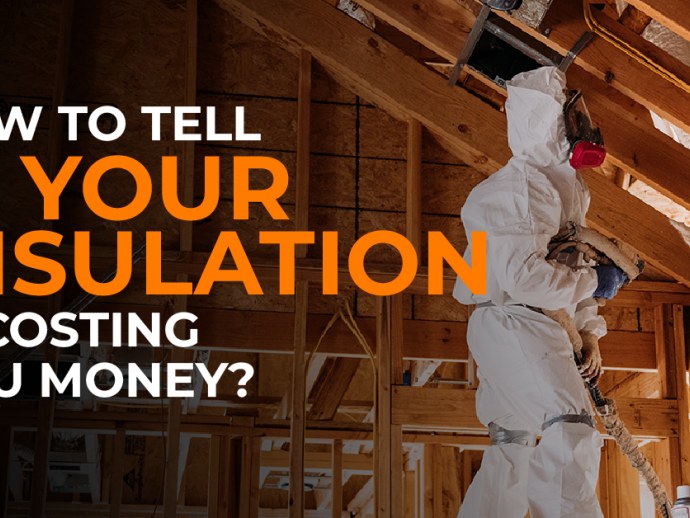How to Tell If Your Insulation Is Costing You Money

Let’s be honest—insulation isn’t exactly the most exciting part of your building. It’s hidden behind walls, up in the ceiling, or buried under floors. But don’t let that fool you. Poor insulation could be quietly draining your profits every single month—especially if you operate in the hot, humid climate of the DFW metroplex.
If your energy bills seem high and your HVAC system is working overtime, your insulation might be the culprit. In this guide, we’ll break down the signs of inefficient insulation, how it impacts your bottom line, and what you can do about it—without the jargon.
Why Insulation Matters for Business Owners in the DFW Metroplex
Energy costs often rank as a top-three monthly expense for business owners in the Dallas-Fort Worth area. If your insulation isn’t doing its job, you’re losing money. Good insulation keeps your building cool in the summer and warm in the winter—helping your HVAC system work less and saving you money over time.
In fact, according to the U.S. Department of Energy, proper insulation can cut heating and cooling costs by up to 20%—especially important for the extreme temperatures in Texas.
5 Signs Your Insulation Is Costing You Money
1. You Notice Big Temperature Swings
Do some parts of your DFW retail space feel like a sauna, while others are freezing? That could be a sign your insulation is uneven or has gaps. Inconsistent temperatures make your HVAC system work harder, which burns more energy (and dollars).
2. Your Energy Bills Keep Climbing
If your electricity bills in Dallas or Fort Worth have been steadily rising and you haven’t changed much in your operations, your insulation might not be holding in conditioned air like it should. Poor insulation lets heat escape in the winter and seep in during the summer.
3. You Feel Drafts
Drafts around windows, doors, or vents often point to air leaks. Insulation problems usually go hand-in-hand with these leaks, and together they create an energy-wasting duo.
4. Your HVAC System Runs Constantly
If your HVAC seems like it never shuts off, that could be a red flag. When your building isn't properly insulated, it takes longer to reach the desired temperature—and that constant running racks up your energy costs.
5. You Haven’t Upgraded in 10+ Years
Insulation standards have improved a lot over the past decade. If your building in the DFW area hasn’t been re-insulated or inspected in years, chances are your insulation isn’t performing as well as it could.
How Much Is Bad Insulation Really Costing You?
Let’s look at the numbers. If you operate a 3,200 sq ft space in Dallas or Fort Worth and your monthly energy bill is around $1,200, poor insulation could be adding 15% to 20% in waste. That’s $180 to $240 every month—or over $2,000 per year—that could be saved with proper insulation.
Over five years, that’s more than $10,000 in potential savings.
Not to mention the hidden costs: early HVAC replacements, uncomfortable staff or customers, and even product damage from humidity or temperature swings common in the Texas climate.
Common Insulation Problems in Commercial Spaces Around Dallas-Fort Worth
-
Compressed Insulation: Insulation loses effectiveness when it’s crushed over time, especially in walls or attics with heavy foot traffic.
-
Gaps and Voids: Missed spots around pipes, ducts, or wiring can let air leak in or out.
-
Moisture Damage: Water leaks can ruin insulation and reduce its R-value (its resistance to heat).
-
Wrong Material for the Climate: Not all insulation types work well in the DFW region. The wrong type can hurt more than help.
What You Can Do: Smart, Low-Disruption Fixes
You don’t need to tear your building apart to fix insulation issues. Here are some cost-effective ways to tighten things up:
-
Get an Energy Audit: Professionals in Dallas-Fort Worth can spot weak spots with infrared scans and recommend specific improvements.
-
Seal Air Leaks First: Before replacing insulation, plug up those drafts with weather stripping, caulk, or spray foam.
-
Add Insulation, Don’t Replace It All: In many cases, topping up your current insulation is enough.
-
Focus on the Roof and Attic: Heat rises, so these areas often give you the biggest return on investment in the Texas heat.
-
Work After Hours: Many upgrades can be done in sections or after business hours to avoid disruption.
Real-World Payback: What the Data Says
According to ENERGY STAR, adding insulation to a commercial building pays for itself in 3 to 5 years. The actual timeline depends on your local energy rates, building layout, and existing insulation levels.
Plus, insulation upgrades in Texas may qualify for Oncor or other local utility rebates. That can speed up your return and lower upfront costs.
Final Thoughts: A Smart Move for Long-Term Gains
Upgrading your insulation isn’t just about going green—it’s about running lean. If you're noticing drafts, rising bills, or an overworked HVAC system, it’s worth checking your insulation.
With minimal disruption and potentially thousands in savings, an insulation upgrade is one of the smartest moves you can make for your business in Dallas, Fort Worth, or the surrounding areas.
Want to find a verified insulation expert who focuses on energy efficiency and sustainable upgrades? Check your local green contractor directory for pros who understand both performance and payback.
